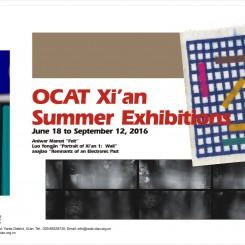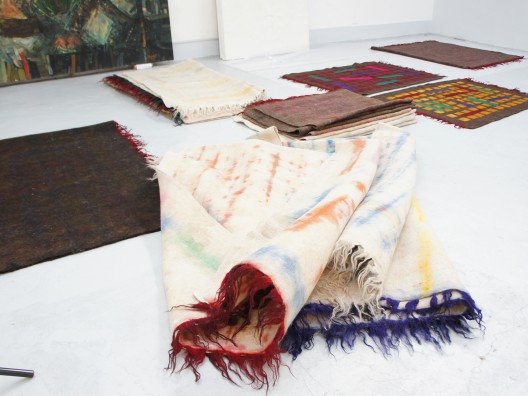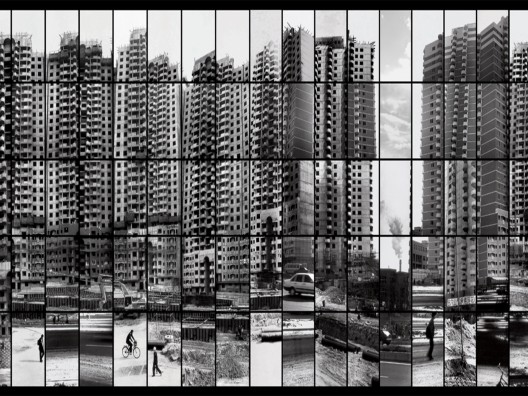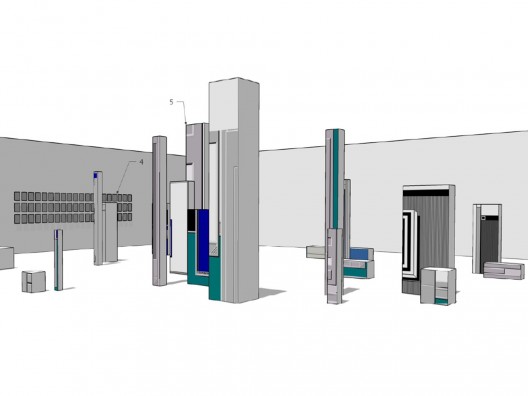[Press release]
The summer exhibition presents three projects from artists each exploring an artistic and historic link to Xi’an in terms of culture and heritage. “Felt”, the centre piece of the summer exhibition, presents news works by Beijing-based abstract artist Aniwar, originally from Xinjiang, which invoke the history of traditional woolen felt carpet-making techniques that can be traced back to the core of the Silk Road trade.
Projects by Luo Yongjin from Luoyang and aaajiao (Xu Wenkai) from Xi’an (both now based in Shanghai) play with visual elements that evoke famous sites like the city wall and the stone stele at Beilin. In Luo Yongjin’s installation, this takes the form of assemblage, with striking black and white photographs overlaid with rubbings, made using traditional techniques.
New media master aaajiao creates a series of “stele” that represent a monument to outmoded versions of familiar software. In an era characterized by the regularity of the “upgrade” in every aspect of the technology and media we use on a daily basis, how quickly software becomes outdated. Here, aaajiao presents a thoughtful and whimsical graveyard to remind us of the speed with which we are accustomed to discarding the old for the sake of something new.
Felt, Aniwar Solo Exhibition, 2016/06/18-2016/09/11
Aniwar’s work is unique within China’s contemporary art, first for his distinctive artistic language, which approaches abstraction. Second, because this artist’s approach draws deeply on his cultural roots, as part of the rich, colorful traditions of aesthetic sensibilities found in Xinjiang and its textile heritage. Aniwar makes paintings, drawings, photo and film works which reflect emotional currents within life. There is, he suggests, an emotional timbre to even the most rigorous of intellectual practices in art—as he previously demonstrated with a series of monochromatic pencil line drawings that he titles Diary—each one carried out within the space of a day, and where the length and intensity of the line reflects the artist’s mood of the day.
Aniwar brings to this tradition a contemporary language—the geometric and spatial arrangements of bands of color. To achieve this, Aniwar worked alongside the craftsmen to determine the range of natural-dye pigments to be used, and the proportions of the strips of felt to be produced and dyed. These were then composed in a painterly pattern by laying the colored bands across the surface of a larger sheet of felt. The whole was then rolled using a bamboo mat—as if making a giant sushi roll—until the material was compressed together and the final form of the paintings was achieved. Aniwar’s felt works are remarkable examples of contemporary textile art unlike the traditional patterns and pictorial motifs used across Central Asia. A link remains however in the sublimation of descriptive motifs, meaning readable pictorial figures, into an abstraction form. This underscores Aniwar’s evolution as an artist over time in which such readable figurations as human forms, flowers, elements of nature, were reduced to pure color and a form of geometric line that is intended to create a spatial sensation on and embedded within the flat surface of a painting or textile work such as those on display in “Felt”.
Portrait of Xi’an 1: “Wall”, Luo Yongjin Photo Project, 2016/06/18-2016/09/11
Luo Yongjin’s photographic works deftly show architecture as a manifestation of a particular time and place: from the Fort Houses in the west of China to the “McMansions” of the wealthy traders in Hangzhou and its environs; from massive commercial developments like Oriental Plaza in Beijing to the grand edifices along the Bund in Shanghai, to the disintegrating traditional houses on the fringes of so many urban centers, the shifting tides of taste, of excess and austerity, of ambition, expense and fantasy invested in these diverse construction projects come to the fore. Both as single images and as mosaic-style composites, the photographs effect a visual metaphor of a dramatic era of social change from the 1980s to the present. The element of documenting a place is preeminent in the works. “I liked how you could express yourself and narrative through documentary photographic images,” he says. “That is how I became interested in photography.” This documentary element will make Luo Yongjin’s body of work increasingly important over time.
Another distinctive element in the work is the experimenting that Luo Yongjin does with established, or traditional, techniques. The “Wall” project embodies a combination of elements; traditional/ancient bricks, rubbings, and photographs printed not on conventional paper but in rice paper. A long-time teacher at Shanghai’s Art Academy, Luo Yongjin says that artists “need to figure out how not to just use the techniques they learn at art academy and to do their own art. Traditionally, the techniques are very strict. Take calligraphy—you have to hold the pen this way, have to move to the right, have to move left, up then down. It’s very tempting just to follow these rules, because students are often paid to just use those techniques. But that’s not really what creates art.”
Remnants of an Electronic Past, aaajiao (Xu Wenkai) special commission, 2016/06/18-2016/09/11
Leading new media artist aaajiao (Xu Wenkai) returns to his native Xi’an this summer with a tribute to the significance embodied by the forest of steles at Beilin Museum, which offer unique examples of early texts; prototypes for fonts and a linguistic lexicon that is still referred to today. To the project, aaajiao brings his own inimical approach to contemporary technology and forms of technological media to muse, in his distinct expressive manner, what happens to outmoded versions of software as technology moves forward, becoming ever more sophisticated? Or, where does software go to die?
Many of aaajiao’s works reflect a new thinking around the phenomenon of the Internet, acknowledging all its inherent controversies and contradictions, with specific projects focusing on data processing, the blogosphere and China’s Great Fire Wall. Hinting at the paradoxical nature of the new values attributed to technological advance vis-à-vis traditional knowledge, with the 2013 project The Weight of Data, aaajiao wanted to know if one could use a standard measurement of value—that of gold—to measure the value of data. “I found a writer on a website and he’s been writing his blog for ten years. I collected all of his data, saved it onto a SD card, and put it on the scale. On the other side of the scale I placed some jewellery. We wanted to see how this data stacked up to the jewellery. The results were obvious—data is really light compared with the jewellery, but what I tried to express was that, right now, these blogs we create are worthless according to ancient views and measurements.”
There is no way to measure this phenomenon in terms of a value judgement, meaning if it is good or bad. For the time being, it simply “is”, engendering a seam of futility and melancholy that reverberates in this elegantly imagined project. “Remnants of an Electronic Past” has particular resonance in Xi’an and the region which is home to some of China’s most advanced technological innovation and thinking.



